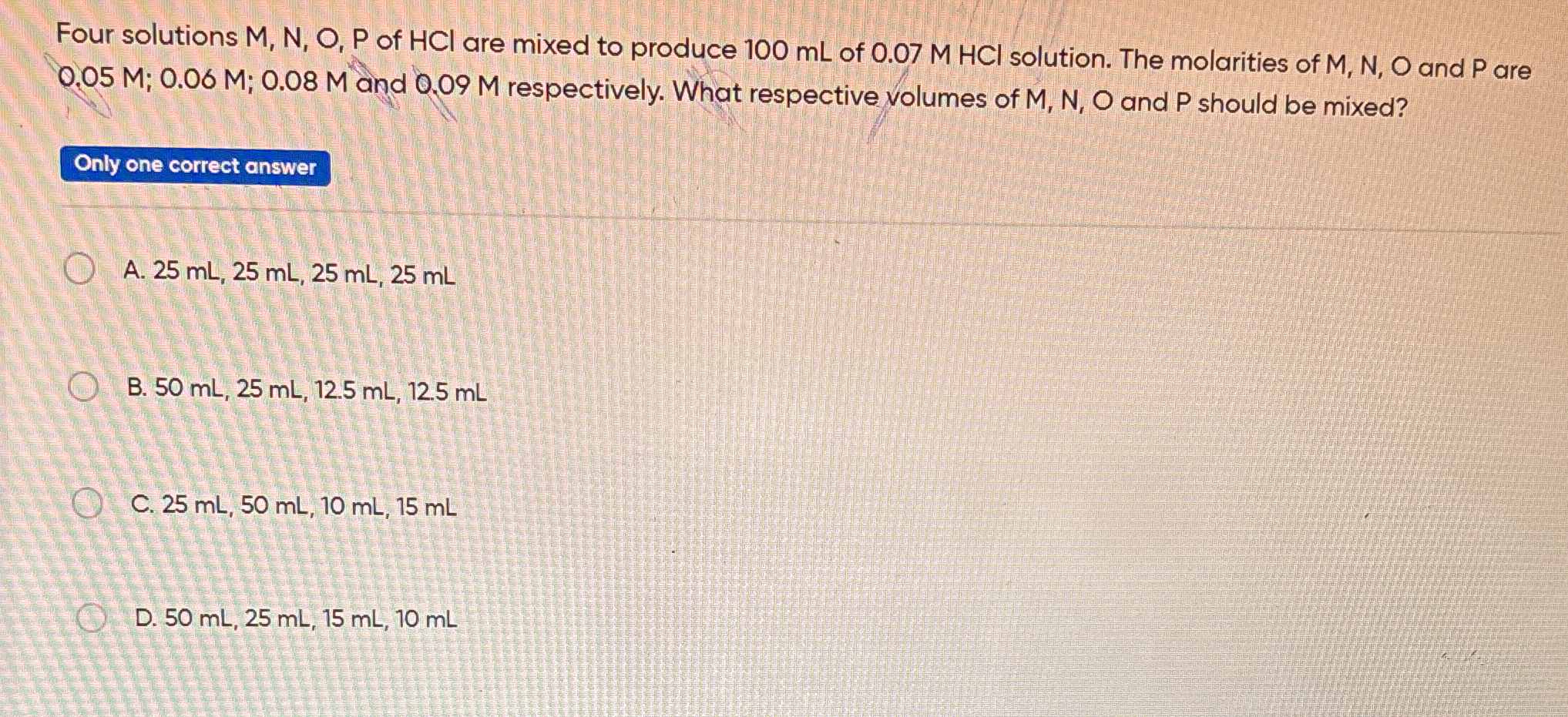Four solutions M, N, O, P of HCl are mixed to produce 100 mL of 0.07 M HCl solution. The molarities of M, N, O and P are 0.05 M, 0.06 M, 0.08 M and 0.09 M respectively. What respec... Four solutions M, N, O, P of HCl are mixed to produce 100 mL of 0.07 M HCl solution. The molarities of M, N, O and P are 0.05 M, 0.06 M, 0.08 M and 0.09 M respectively. What respective volumes of M, N, O and P should be mixed?

Understand the Problem
The question is asking what volumes of four solutions of HCl (with different molarities) need to be mixed to create 100 mL of a 0.07 M HCl solution. This involves understanding molarity and dilution principles in chemistry.
Answer
The volumes are \( 25 \, \text{mL}, 25 \, \text{mL}, 25 \, \text{mL}, 25 \, \text{mL} \).
Answer for screen readers
The required volumes of M, N, O, and P are: ( 25 , \text{mL}, 25 , \text{mL}, 25 , \text{mL}, 25 , \text{mL} ).
Steps to Solve
- Understand the total moles needed
To create 100 mL of a 0.07 M solution, calculate the total number of moles of HCl required: $$ \text{Moles} = \text{Molarity} \times \text{Volume (L)} = 0.07 , \text{mol/L} \times 0.1 , \text{L} = 0.007 , \text{mol} $$
- Set up the equations for each solution
Let:
- ( V_M ) = volume of solution M
- ( V_N ) = volume of solution N
- ( V_O ) = volume of solution O
- ( V_P ) = volume of solution P
We know from the problem:
- ( V_M + V_N + V_O + V_P = 100 ) mL
The contributions of each solution to the total moles are: $$ \frac{0.05 , \text{mol/L} \cdot V_M + 0.06 , \text{mol/L} \cdot V_N + 0.08 , \text{mol/L} \cdot V_O + 0.09 , \text{mol/L} \cdot V_P}{1000} = 0.007 $$
- Simplify the second equation
Multiply the entire moles equation by 1000 to remove the fraction: $$ 0.05 V_M + 0.06 V_N + 0.08 V_O + 0.09 V_P = 7 $$
- Solve the system of equations
You now have a system of two equations:
- ( V_M + V_N + V_O + V_P = 100 )
- ( 0.05 V_M + 0.06 V_N + 0.08 V_O + 0.09 V_P = 7 )
To solve these equations, you can express ( V_P ) in terms of the others from the first equation and substitute it in the second equation.
- Trial with the options given
You can substitute the values from each option presented in the question to see which combination satisfies both equations.
- For option A: ( V_M = V_N = V_O = V_P = 25 ) mL
- Total moles: $$ 0.05(25) + 0.06(25) + 0.08(25) + 0.09(25) = 1.25 + 1.5 + 2 + 2.25 = 7 , \text{moles.} $$
- Total volume: ( 25 + 25 + 25 + 25 = 100 , \text{mL.} )
This satisfies both conditions.
The required volumes of M, N, O, and P are: ( 25 , \text{mL}, 25 , \text{mL}, 25 , \text{mL}, 25 , \text{mL} ).
More Information
The solution shows that each of the four solutions contributes equally to the final mixture, and all molarities are arranged to achieve exactly the required concentration. Moreover, this demonstrates the principles of dilution and mixture calculations in chemistry.
Tips
- Forgetting to convert mL to L for molarity calculations.
- Miscalculating the total needed moles or volume.
- Not checking each option against the requirements.
AI-generated content may contain errors. Please verify critical information